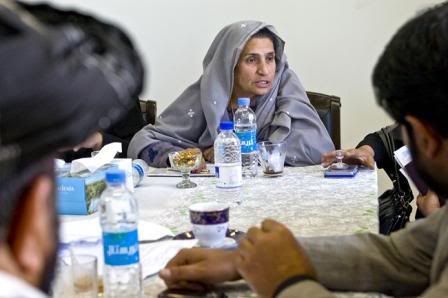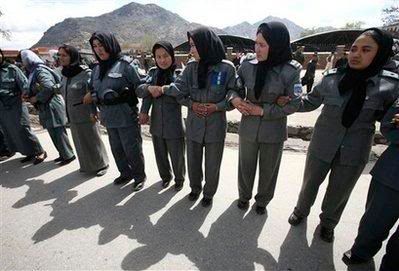In her documentary series ‘Behind the Veil,’ Photographer Paula Lerner went into Kandahar and interviewed women there. Her findings, published this week in the Globe and Mail revealed the stark inequity between women and men, and the abuses of women’s rights that still persist to this day. The women interviewed express desires for education, for security, for opportunity in a world they see as swallowing them whole. Many of those interviewed who are married speak of abuses at the hands of their spouses or their spouses families. Those who are unmarried speak with fear about the prospects since 70-80% of women in Afghanistan face forced marriages(1), even under government legislation aimed at preventing such.
Article 22 [Equality]
(1) Any kind of discrimination and privilege between the citizens of Afghanistan are prohibited.
(2) The citizens of Afghanistan -- whether man or woman -- have equal rights and duties before the law.
Life has never been easy for the women of Afghanistan. Under the Taliban rule, the oppressive religious garments the burqa and chadri were enforced for moral and religious reasons. Women were forbidden from holding jobs, from going to school and even from leaving the home without their husband’s permission. They were forbidden from seeking medical attention from male doctors, even during childbirth.(3) As the female nurses and doctors who had previously been members of the professional and academic communities had been forced out of work when the Taliban took power, many women died in labour. Even now, following the NATO invasion of the country, an Afghan woman dies approximately every 30 minutes in childbirth. The average life expectancy for women in the country is a shocking 44.(4)
It has been common practice for girls as young as 14 to be married off to men who are two or even three times their age. Families, in fact, expect a degree of compensation for raising daughters to childbearing age, with amounts up to 700,000 Afghanis ($15,000) being demanded of prospective husbands. These paid, arranged marriages have produced two results; first the misconception amongst Afghan men that women, (as they have been purchased) are property and second that they can be treated in whatever manner a husband sees fit. One in every three Afghan women will at some time experience physical, psychological or sexual violence either at home or in their communities.(5)
The Pashtun belt is an enormous tribal zone, where the primary language is Pashto (though many also speak Persian Dari). It straddles the border between Afghanistan and Pakistan and it is the region the majority of the Taliban hail from. This is a rural population, and even in the urban center of Kandahar, religious conservatism and traditionalism in thought and deed are upheld as the only ethics. Despite the 2004 Afghan constitution promising equal rights and duties before the law, for both women and men (6) little has been done in the lawless tribal regions, or the conservative cities to redress these wrongs. A goal of eliminating forced and child marriage by 2008 (7) has yet to be realized and recent legislation labeled ‘Shia Family Law’ further erodes the possibilities for true gender equity in the troubled nation. The law essentially permits a husband to pursue sexual intercourse with his wife at any time, forbidding women from refusing to perform their ‘marital duties.’ (8)
The lack of access to education is another major roadblock for the progression of women’s rights. 87% of the country’s women are illiterate, few having completed elementary school before being married off and forced into a life of service to their new husbands. (9) In the recent elections, 35% of women did not believe they were going to be allowed to vote and 18% of husbands stated that they did not intend to permit their wives to do so. (10) These bleak statistics paint a picture of a nation in which democracy is impossible to achieve while half the population is still held ignorant and voiceless. A prominent female politician, Sitara Achakzai who worked to improve the condition of Human Rights in Afghanistan was murdered in cold blood by Taliban while taking a taxi. The Afghan born leader had emigrated to Germany where she married, before returning to Afghanistan to serve as a member of regional parliament in the years leading up to her assassination. The 52 year old was upheld as a symbol of the future Afghan women playing a role in the shaping of their own society and culture. (11)
Prominent Women's rights activist and regional politician, Sitara Achakzai was murdered by Taliban who saw her as a direct threat to the harsh religious order they are trying to enforce in Afghanistan's volatile south.
What will come now, and in the aftermath of the coalition’s war against the Taliban remains to be seen. There are those, perhaps the noblest amongst their sisters who are following a growing trend of women joining the security and police forces, hoping to work for the new government to improve their own nation. These women face the worst forms of violence and abuse, not only domestically, but at the hands of militants who target them specifically to reinforce the point that female participation in law and order will not be tolerated. (12) A resurgence of violence and conservatism has robbed hope from many other women who only a few years ago removed the veil and emerged from their homes to greet the new world of opportunity that awaited them. As public opinion for the costly conflict wanes in the West, it is the women of Afghanistan, young and old who have perhaps the most to lose.
Female Afghan police officers report for training by ISAF personnel. Women are playing a growing role in the long-term security of the nation as many are willing to put their lives on the line for the sake of their homeland.
1. UNIFEM Afghanistan: Afghan Women's Statistics
2. SupremeCourt.gov - Afghan Constitution (PDF)
3. Wikipedia - The Treatment of Women Under the Taliban
4. UNIFEM Afghanistan: Afghan Women's Statistics
5. UNIFEM Afghanistan: Afghan Women's Statistics
6. SupremeCourt.gov - Afghan Constitution (PDF)
7. BBC - Panorama: Afghan Women Fight for Rights
8. Wikipedia- Shia Family Law
9. UNICEF Afghanistan: Afghanistan Statistics
10. The Globe and Mail - Behind the Veil
11. CBC News - Women's Rights Activist Shot Dead in Southern Afghanistan
12. CTV- Female Afghan Police Officers Brave Death Threats
.jpg)


No comments:
Post a Comment